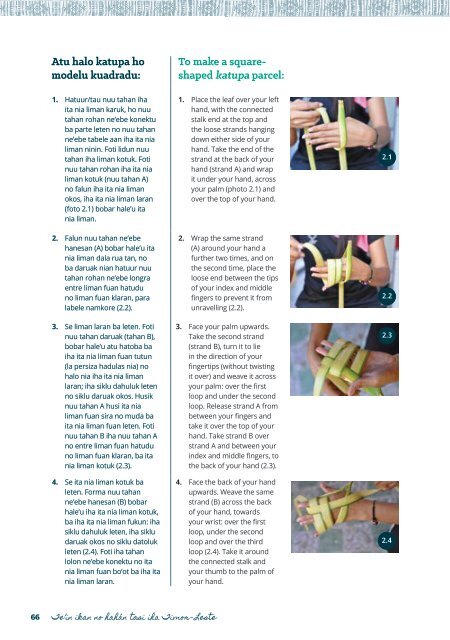Create successful ePaper yourself
Turn your PDF publications into a flip-book with our unique Google optimized e-Paper software.
Atu halo katupa ho<br />
modelu kuadradu:<br />
To make a squareshaped<br />
katupa parcel:<br />
1. Hatuur/tau nuu tahan iha<br />
ita nia liman karuk, ho nuu<br />
tahan rohan ne’ebe konektu<br />
ba parte leten no nuu tahan<br />
ne’ebe tabele aan iha ita nia<br />
liman ninin. Foti lidun nuu<br />
tahan iha liman kotuk. Foti<br />
nuu tahan rohan iha ita nia<br />
liman kotuk (nuu tahan A)<br />
no falun iha ita nia liman<br />
okos, iha ita nia liman laran<br />
(foto 2.1) bobar hale’u ita<br />
nia liman.<br />
2. Falun nuu tahan ne’ebe<br />
hanesan (A) bobar hale’u ita<br />
nia liman dala rua tan, no<br />
ba daruak nian hatuur nuu<br />
tahan rohan ne’ebe longra<br />
entre liman fuan hatudu<br />
no liman fuan klaran, para<br />
labele namkore (2.2).<br />
3. Se liman laran ba leten. Foti<br />
nuu tahan daruak (tahan B),<br />
bobar hale’u atu hatoba ba<br />
iha ita nia liman fuan tutun<br />
(la persiza hadulas nia) no<br />
halo nia iha ita nia liman<br />
laran; iha siklu dahuluk leten<br />
no siklu daruak okos. Husik<br />
nuu tahan A husi ita nia<br />
liman fuan sira no muda ba<br />
ita nia liman fuan leten. Foti<br />
nuu tahan B iha nuu tahan A<br />
no entre liman fuan hatudu<br />
no liman fuan klaran, ba ita<br />
nia liman kotuk (2.3).<br />
4. Se ita nia liman kotuk ba<br />
leten. Forma nuu tahan<br />
ne’ebe hanesan (B) bobar<br />
hale’u iha ita nia liman kotuk,<br />
ba iha ita nia liman fukun: iha<br />
siklu dahuluk leten, iha siklu<br />
daruak okos no siklu datoluk<br />
leten (2.4). Foti iha tahan<br />
lolon ne’ebe konektu no ita<br />
nia liman fuan bo’ot ba iha ita<br />
nia liman laran.<br />
1. Place the leaf over your left<br />
hand, with the connected<br />
stalk end at the top and<br />
the loose strands hanging<br />
down either side of your<br />
hand. Take the end of the<br />
strand at the back of your<br />
hand (strand A) and wrap<br />
it under your hand, across<br />
your palm (photo 2.1) and<br />
over the top of your hand.<br />
2. Wrap the same strand<br />
(A) around your hand a<br />
further two times, and on<br />
the second time, place the<br />
loose end between the tips<br />
of your index and middle<br />
fingers to prevent it from<br />
unravelling (2.2).<br />
3. Face your palm upwards.<br />
Take the second strand<br />
(strand B), turn it to lie<br />
in the direction of your<br />
fingertips (without twisting<br />
it over) and weave it across<br />
your palm: over the first<br />
loop and under the second<br />
loop. Release strand A from<br />
between your fingers and<br />
take it over the top of your<br />
hand. Take strand B over<br />
strand A and between your<br />
index and middle fingers, to<br />
the back of your hand (2.3).<br />
4. Face the back of your hand<br />
upwards. Weave the same<br />
strand (B) across the back<br />
of your hand, towards<br />
your wrist: over the first<br />
loop, under the second<br />
loop and over the third<br />
loop (2.4). Take it around<br />
the connected stalk and<br />
your thumb to the palm of<br />
your hand.<br />
2.1<br />
2.2<br />
2.3<br />
2.4<br />
66<br />
Te’in ikan no hahán tasi iha Timor - <strong>Leste</strong>

















